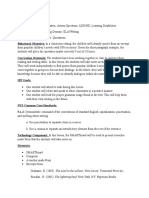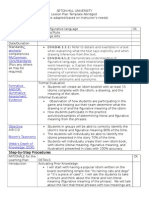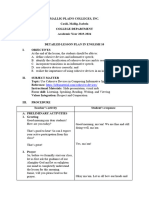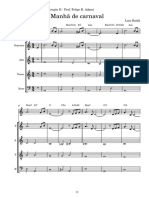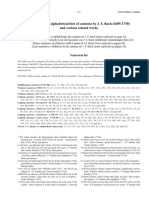Exercises On Using Cohesive Devices
Exercises On Using Cohesive Devices
Uploaded by
Dian Mae PamplonaCopyright:
Available Formats
Exercises On Using Cohesive Devices
Exercises On Using Cohesive Devices
Uploaded by
Dian Mae PamplonaOriginal Description:
Original Title
Copyright
Available Formats
Share this document
Did you find this document useful?
Is this content inappropriate?
Copyright:
Available Formats
Exercises On Using Cohesive Devices
Exercises On Using Cohesive Devices
Uploaded by
Dian Mae PamplonaCopyright:
Available Formats
EXERCISES ON USING COHESIVE DEVICES
Part A:
Fill in the blanks using AND, SO, BECAUSE, BUT or OR.
1. I could not go out last night _____ I was too busy.
2. I could not go with my friend _____ he went without me.
3. My friend went to the cinema to see a film _____ the film wasn't very
good.
4. The cinema was full of people _____ they were all smoking.
5. I like people ____ I don't like smoke.
6. Do you want an orange juice ____ a guava juice?
7. It was my birthday _____ he didn't send me a card.
8. I didn't write to him _____ he didn't write to me.
9. We couldn’t contact him _____ we didn’t have his number.
10. The new department store is now open _____ it is offering big
discounts.
Part B:
Complete the short story below with appropriate cohesive devices.
Mary could not go out with me _____ I invited Anne instead. Anne was
very happy to accept my invitation _____ the film was very popular. Anne
and I had a good time _____ next day Mary was very angry. "Do you love
me _____ do you love Anne?" she asked me. "I like both you _____
Anne," I answered. "Look!" said Mary. "Either you go out with me _____
you go out with Anne. You can't love both me _____ Anne at the same
time." "Why not?" I answered. "_____ it's not fair." I asked Mary if she
would go out with me tonight _____ she said that she had a new
boyfriend _____ didn't want to see me again _____ I didn't really love
her. I phoned Anne _____ she said she was busy _____ now I'm alone.
PART C
Combine the following pairs of sentences to be one sentence.
Use appropriate cohesive device(s).
For example:
The little boy walked to the store.
His dog walked along with him.
🡪 When the little boy walked to the store, his dog walked along with him.
1. Bob is an only child. He is very independent.
2. You have to bring your examination card. You cannot join the exam
without the examination card.
3. She went to work. She didn’t want to go.
4. My cat was hungry. It had not eaten since breakfast that day.
5. A book can be a lot of fun. A book can be boring.
6. Her wallet fell to the floor. A photo of her boyfriend came out of it.
7. Andy watched her favorite TV show. Andy went to bed.
8. Karen and Sally are best friends. Karen and Sally have many things
in common.
9. They made plan to go to the beach. They couldn’t do it.
10.I couldn’t sleep that night. I was too tired the next morning.
PART D.
Make less number of sentences by combining as many sentences as you
can in the following paragraph, using the above examples to guide you.
The Garuda team was three games down. The Garuda team had to win
the next four games to move to the next round. Fans of Garuda were
worried. Garuda had not won any championship for four years. No team
had ever come back in the playoffs from a three-game deficit. All of the
Garuda fans knew this. The fans of the Garuda watched anxiously as the
fourth game against the Bear began. The fans of the Bear watched
confidently. The Bear had a good chance to win the match. The fans of the
Bear knew this. Nobody believed the Garuda would win that year. The
Garuda won the match that year.
You might also like
- "Safer" From First DateDocument3 pages"Safer" From First DateTimothy Boaz100% (10)
- Lesson Plan Sequence For To Kill A Mockingbird by Harper LeeDocument11 pagesLesson Plan Sequence For To Kill A Mockingbird by Harper Leeapi-273178074No ratings yet
- Vocabulary Test For Senior HighDocument1 pageVocabulary Test For Senior High黃煜凱No ratings yet
- Cohesive DeviceDocument4 pagesCohesive DevicejudyNo ratings yet
- Paraphrasing MCQ Exercise 3Document4 pagesParaphrasing MCQ Exercise 3David Effendy100% (1)
- Theoretical Course of English GrammarDocument7 pagesTheoretical Course of English GrammarShalva100% (1)
- Cohesive DevicesDocument1 pageCohesive DevicesPatricia Carla Undang0% (1)
- Module 1 To Module 2 (Lesson 1)Document23 pagesModule 1 To Module 2 (Lesson 1)Micahella BalinasNo ratings yet
- Grammatically Correct SentencesDocument6 pagesGrammatically Correct SentencesSamuel AntobamNo ratings yet
- Cohesive DevicesDocument1 pageCohesive Devicesamasom50% (2)
- Quiz Number 1 Function Word and Content WordsDocument2 pagesQuiz Number 1 Function Word and Content WordsChristian Edezon Lopez0% (1)
- Activity Sheet in English 8: ExploreDocument7 pagesActivity Sheet in English 8: ExploreedsonNo ratings yet
- Indefinite Pronouns: LC 1.2 Students Should Be Able To Identify and Correctly Use Indefinite PronounsDocument10 pagesIndefinite Pronouns: LC 1.2 Students Should Be Able To Identify and Correctly Use Indefinite PronounsGilGabayNo ratings yet
- Teacher's Questionnaire - Google Forms Teaching SpeakingDocument3 pagesTeacher's Questionnaire - Google Forms Teaching SpeakingSa MiraNo ratings yet
- Types of Sentences ExercisesDocument2 pagesTypes of Sentences Exercisesmohammad Zaki100% (1)
- Complex Sentence Structure, Definition and Examples 52 SlidesDocument18 pagesComplex Sentence Structure, Definition and Examples 52 SlidesToh Choon Hong100% (2)
- Subject - Verb Agreement - QuizDocument3 pagesSubject - Verb Agreement - QuizRose Mariel GuerreroNo ratings yet
- Verbals Lesson PlanDocument8 pagesVerbals Lesson PlanAriane BatuaNo ratings yet
- Cohesive Devices Exercise OdetteDocument4 pagesCohesive Devices Exercise OdetteJeanetta Jonathan100% (2)
- Argument Essay Lesson PlanDocument3 pagesArgument Essay Lesson PlanWMitten100% (1)
- Quotations Lesson PlanDocument5 pagesQuotations Lesson Planapi-313105261No ratings yet
- To Teach or Not Teach GrammarDocument5 pagesTo Teach or Not Teach Grammaraphrodita44No ratings yet
- Short Story Analysis RubricDocument3 pagesShort Story Analysis RubricLorybelle Castillo100% (1)
- TRansactional Vs InteractionalDocument8 pagesTRansactional Vs Interactionaljeniva roseNo ratings yet
- ConjunctionDocument33 pagesConjunctionJoni0% (1)
- Syllabus - Language Testing and AssessmentDocument5 pagesSyllabus - Language Testing and AssessmentComaythang5No ratings yet
- LogicalDocument8 pagesLogicalMharlone Chopap-ingNo ratings yet
- Lesson Plan 1Document4 pagesLesson Plan 1api-239772422No ratings yet
- Cohesive DevicesDocument5 pagesCohesive DevicesMargielyn Tiburcio Marte - AngayNo ratings yet
- Reading Passage 1aDocument2 pagesReading Passage 1aAldo Yosadiano PNo ratings yet
- Synthesis InfoDocument43 pagesSynthesis InfoMaridel DiamsayNo ratings yet
- Cause and Effect WorksheetDocument1 pageCause and Effect WorksheetSir Mon100% (1)
- Communicative StylesDocument1 pageCommunicative StylesMa Glenda Brequillo SañgaNo ratings yet
- General Rules For Active Voice and Passive VoiceDocument21 pagesGeneral Rules For Active Voice and Passive VoiceGulfam RazaNo ratings yet
- History of English Language (Syllabus)Document3 pagesHistory of English Language (Syllabus)jonalyn obinaNo ratings yet
- Demo Le-Grade 9Document7 pagesDemo Le-Grade 9JEROME SALAYNo ratings yet
- Presentation - 1st Week - Spread of World EnglishDocument11 pagesPresentation - 1st Week - Spread of World EnglishCandan ülküNo ratings yet
- Preposition of LocationDocument2 pagesPreposition of LocationDyana Baharom ديانابهارومNo ratings yet
- Content Area To Be Tested No. of Meetings Level of Cognitive RequiredDocument1 pageContent Area To Be Tested No. of Meetings Level of Cognitive RequiredMhae ShahNo ratings yet
- 5 Stages of Language AcquisitionDocument2 pages5 Stages of Language AcquisitionMuhammadMalek0% (1)
- Conjunctions and InterjectionsDocument28 pagesConjunctions and InterjectionsKaren Delos Santos Toledo100% (1)
- 5es Lesson PlanDocument3 pages5es Lesson PlanAbbegail B BunioNo ratings yet
- 2 Intonation and StressDocument27 pages2 Intonation and StressdiwiyanaNo ratings yet
- Tranistions - Signal WordsDocument17 pagesTranistions - Signal WordsAnonymous nMG8p5E1100% (1)
- Emotive Language ExampleDocument9 pagesEmotive Language ExampleBernie Victor100% (1)
- Idiom Lesson PlanDocument5 pagesIdiom Lesson Planapi-280008473No ratings yet
- Direct Indirect Speech Question and AnswersDocument4 pagesDirect Indirect Speech Question and AnswersDebii0% (1)
- Communicative Language Teaching Lesson PlanDocument3 pagesCommunicative Language Teaching Lesson PlanStoica MirelaNo ratings yet
- 5 Sense Properties, Stereotype, & Sense RelationDocument62 pages5 Sense Properties, Stereotype, & Sense RelationNisaafinaaNo ratings yet
- Using Modals Lesson Plan With Worksheets and BINGO CardDocument9 pagesUsing Modals Lesson Plan With Worksheets and BINGO CardSITTI MONA MAGTACPAO0% (1)
- TOPIC 4 - Overloaded Sentences Padded and Empty Sentences HandoutDocument9 pagesTOPIC 4 - Overloaded Sentences Padded and Empty Sentences HandoutAlexis Müller100% (1)
- Imperative Sentence: Competency /objectivesDocument3 pagesImperative Sentence: Competency /objectivesJaymar MagtibayNo ratings yet
- Using Cohesive Devises in Composing Informative SpeechDocument20 pagesUsing Cohesive Devises in Composing Informative SpeechRichna LozanoNo ratings yet
- Conditionals Quiz 3Document3 pagesConditionals Quiz 3Ana SarbuNo ratings yet
- English 8: Department of EducationDocument8 pagesEnglish 8: Department of EducationKarla HalninNo ratings yet
- Double Comparison: A. Combine The Sentences, Using DOUBLE COMPARATIVEDocument2 pagesDouble Comparison: A. Combine The Sentences, Using DOUBLE COMPARATIVEnew trendNo ratings yet
- Cohesive Devices - 1Document14 pagesCohesive Devices - 1Timothy Justin Francisco100% (1)
- Analyzing The Information Contained in The Material ViewedDocument15 pagesAnalyzing The Information Contained in The Material ViewedMa. Maureen DariaNo ratings yet
- Elliptical Sentence: A. Positive EllipticDocument7 pagesElliptical Sentence: A. Positive EllipticIndah NurainiNo ratings yet
- G8 Cohesive DevicesDocument2 pagesG8 Cohesive DevicesJason PasteraNo ratings yet
- Cohesive DevicesDocument1 pageCohesive DevicesHoneygirl Joyce NwaigweNo ratings yet
- Mock CAT - 4: InstructionsDocument24 pagesMock CAT - 4: InstructionsmonuvinitNo ratings yet
- Cover Letter and ResumeDocument3 pagesCover Letter and Resumeapi-604534203No ratings yet
- DILTON - Manhã de Carnaval (4 Vozes)Document2 pagesDILTON - Manhã de Carnaval (4 Vozes)Dilton NatalNo ratings yet
- Niyugyugan A FestivityDocument20 pagesNiyugyugan A FestivityJOSCELLE JOYCE RIVERANo ratings yet
- Look To YouDocument8 pagesLook To YouChanelle Honey CruzNo ratings yet
- 2 Shahabaz Aman DiscographyDocument17 pages2 Shahabaz Aman Discographyfndf88No ratings yet
- Volume 62 T X SeriesDocument6 pagesVolume 62 T X SerieseyaustriaNo ratings yet
- Music Artist SponsorshipDocument10 pagesMusic Artist SponsorshipMarshall - MuzeNo ratings yet
- Amhran Na Bhfiann (The Soldier'S Song) : Liam O'Rinn Patrick HeeneyDocument1 pageAmhran Na Bhfiann (The Soldier'S Song) : Liam O'Rinn Patrick HeeneypttnpttnNo ratings yet
- ECE 5221 Personal Communication Systems: Prepared By: Dr. Ivica KostanicDocument13 pagesECE 5221 Personal Communication Systems: Prepared By: Dr. Ivica KostanicalperusluNo ratings yet
- Cifra - AC - DC - Back in BlackDocument3 pagesCifra - AC - DC - Back in BlackJéssica ReisNo ratings yet
- IRREGULAR VERBS - MPA 4èDocument2 pagesIRREGULAR VERBS - MPA 4èmariepalmNo ratings yet
- EMI Troubleshooting App Note 48W 67730 0Document22 pagesEMI Troubleshooting App Note 48W 67730 0john BronsonNo ratings yet
- RESPIGHI, Ottorino - Violin Sonata in B MinorDocument43 pagesRESPIGHI, Ottorino - Violin Sonata in B MinorK.L.No ratings yet
- Renaissance Baroque and Classical MusicDocument3 pagesRenaissance Baroque and Classical MusicDiane Grace Seludo0% (1)
- (Free Scores - Com) Leontovich Mykola Ring Christmas Bells For Handbells Handchimes Choir Satb Full Score 7924 70566Document5 pages(Free Scores - Com) Leontovich Mykola Ring Christmas Bells For Handbells Handchimes Choir Satb Full Score 7924 70566ChristineNo ratings yet
- FenrizDocument3 pagesFenrizDarkoNo ratings yet
- UP To B2. Phrasal VerbsDocument11 pagesUP To B2. Phrasal Verbsirinakolosovska65No ratings yet
- IPRDocument22 pagesIPRVishnu Manoharan ChettiarNo ratings yet
- Music Scheme of Work For p.1 Term 2Document7 pagesMusic Scheme of Work For p.1 Term 2Monydit SantinoNo ratings yet
- Bounce Now HSW Level 3Document28 pagesBounce Now HSW Level 3Marita Castro GonzàlesNo ratings yet
- Handbook: Published On MusescoreDocument50 pagesHandbook: Published On MusescoreKellyn Ritchey CarpenterNo ratings yet
- Top 1000 HF FrequenciesDocument18 pagesTop 1000 HF FrequenciesJohn EarleyNo ratings yet
- MKT AnDocument6 pagesMKT AnInformation for InvestorsNo ratings yet
- Bach Lista CantatelorDocument10 pagesBach Lista CantatelorDragos Mihai CohalNo ratings yet
- A Brief History of The GuitarDocument10 pagesA Brief History of The GuitarRaajeswaran BaskaranNo ratings yet
- Outreach Program Reflection Paper: by Geraldine M. CastelltortDocument2 pagesOutreach Program Reflection Paper: by Geraldine M. CastelltortMarkJoven LagramaNo ratings yet
- A Thing For Leo GrantDocument3 pagesA Thing For Leo GrantMatthew Lee KnowlesNo ratings yet
- Chromatic Fantasia For Viola Solo (Kodály)Document6 pagesChromatic Fantasia For Viola Solo (Kodály)Sam ChanNo ratings yet




















